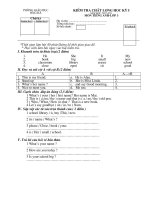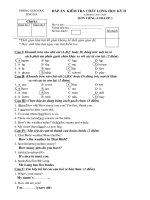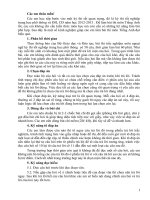Đề thi môn tiếng anh căn bản 3 docx
Bạn đang xem bản rút gọn của tài liệu. Xem và tải ngay bản đầy đủ của tài liệu tại đây (86.27 KB, 12 trang )
KHOA NGOẠI NGỮ
TỔ TIẾNG ANH KHÔNG CHUYÊN
*****
ĐỀ THI SỐ 46
I. Em hãy kể về kỳ nghỉ hè vừa qua của em.
II. Hoàn thành các câu sau:
1- My brother / a bit taller / me
2- Who/ you/ look like/ family?
3- How often/ you / go/ cinema?
III. Em sẽ nói bằng tiếng Anh như thế nào trong các tình huống sau:
1- Em muốn biết bạn em đi đâu vào chủ nhật trước.
2. Em muốn mời một người bạn ăn tối.
IV. Hội thoại với thầy, cô giáo.
KHOA NGOẠI NGỮ
TỔ TIẾNG ANH KHÔNG CHUYÊN
*****
ĐỀ THI SỐ 47
I. Em hãy kể về mẹ em.
II. Đặt câu hỏi cho các câu sau:
1- I went by bicycle
2- I’m doing my homework
3- He looks like his farther
III. Em sẽ nói bằng tiếng Anh như thế nào trong các tình huống sau:
1- Em muốn nói rằng em rất thích bơi lội
2. Em muốn biết tối nay bạn em có ở nhà không?
IV. Hội thoại với thầy, cô giáo.
KHOA NGOẠI NGỮ
TỔ TIẾNG ANH KHÔNG CHUYÊN
*****
ĐỀ THI SỐ 48
I. Em hãy kể về một người bạn của em.
II. Biến đổi động từ trong ngoặc cho phù hợp.
1- he usually (go) on foot?
2- How much (cost) your jacket?
3- Where you (go) next holiday?
III. Em sẽ nói bằng tiếng Anh như thế nào trong các tình huống sau:
1- Em mượn đồng hồ của anh trai trong hai ngày.
2. Em muốn biết bạn em có về nhà vào thứ 7 tới không?
IV. Hội thoại với thầy, cô giáo.
KHOA NGOẠI NGỮ
TỔ TIẾNG ANH KHÔNG CHUYÊN
*****
ĐỀ THI SỐ 49
I. Em hãy kể về gia đình của em.
II. Điền giới từ thích hợp vào chỗ trống:
1- Are you good learning English?
2- What does your sister do her free time?
3- My birthday is June 16th
III. Em sẽ nói bằng tiếng Anh như thế nào trong các tình huống sau:
1- Em muốn biết mẹ của bạn em là người như thế nào?
2. Em muốn biết bạn em có thường hay xem ti vi không?
IV. Hội thoại với thầy, cô giáo.
KHOA NGOẠI NGỮ
TỔ TIẾNG ANH KHÔNG CHUYÊN
*****
ĐỀ THI SỐ 50
I. Em hãy kể về sở thích của em.
II. Điền đoạn hội thoại sau:
A. Cambridge 312058.
B. Hi . . . . . . . . is Bob Is . . . . . . . Ann?
A. Yes. hi, Bob
B. I speak to Jill?
A. I’m afraid she’s not at the moment. Can I . . . . ?
III. Em sẽ nói bằng tiếng Anh như thế nào trong các tình huống sau:
1- Em muốn biết ngày mai là thứ mấy?
2. Vay gạo từ một người hàng xóm mới chuyển đến.
IV. Hội thoại với thầy, cô giáo.
KHOA NGOẠI NGỮ
TỔ TIẾNG ANH KHÔNG CHUYÊN
*****
ĐỀ THI SỐ 51
I. Em hãy kể về quê hương em.
II. Hoàn thành đoạn hội thoại sau:
A-What . . . . ing?
B- Chocolate . . . . . . like some?
A- No, thanks like chocolate.
III. Em sẽ nói bằng tiếng Anh như thế nào trong các tình huống sau:
1- Em muốn biết bạn em thường nghe nhạc khi nào?
2. Em muốn hỏi mượn xe máy của bố một ngày
IV. Hội thoại với thầy, cô giáo.
KHOA NGOẠI NGỮ
TỔ TIẾNG ANH KHÔNG CHUYÊN
*****
ĐỀ THI SỐ 52
I. Em hãy kể về anh (em trai hoặc chị em gái).
II. Hoàn thành đoạn hội thoại sau:
A go to the cinema tonight?
B. No, let’s theatre
A. No, it’s too far
B. OK. Why go and see mother?
A. Good idea . OK
III. Em sẽ nói bằng tiếng Anh như thế nào trong các tình huống sau:
1- Em muốn mời bạn em uống một tách cà phê
2. Từ chối khi có người hỏi mượn xe đạp của em
IV. Hội thoại với thầy, cô giáo.
KHOA NGOẠI NGỮ
TỔ TIẾNG ANH KHÔNG CHUYÊN
*****
ĐỀ THI SỐ 53
I. Em hãy kể về ngày nghỉ cuối tuần của em
II. Điền a, an, the hoặc - vào chỗ trống.
1- Do you like apple juice?
2- Where are bananas? On table.
3- I often have egg for my breakfast
III. Em sẽ nói bằng tiếng Anh như thế nào trong các tình huống sau:
1- Em muốn nói rằng em học giỏi môn toán.
2- Em muốn nói với bạn em rằng bạn ấy trông rất giống một diễn
viên điện ảnh.
IV. Hội thoại với thầy, cô giáo.
KHOA NGOẠI NGỮ
TỔ TIẾNG ANH KHÔNG CHUYÊN
*****
ĐỀ THI SỐ 54
I. Em hãy kể về bản thân
II. Điền a, an, some, any vào chỗ trống.
1- There isn’t apple juice in the fridge.
2- I’m very hungry. I have bread . Would you like ?
3- I’m looking for cheap shoes
III. Em sẽ nói bằng tiếng Anh như thế nào trong các tình huống sau:
1- Em muốn hỏi đường đến bệnh viện gần nhất.
2- Em muốn xem mấy chiếc áo len vàng trong cửa hiệu.
IV. Hội thoại với thầy, cô giáo.
KHOA NGOẠI NGỮ
TỔ TIẾNG ANH KHÔNG CHUYÊN
*****
ĐỀ THI SỐ 27
I. Em hãy kể về gia đình em.
II. Điền từ trong ngoặc cho đúng thì.
1- My father always (spend) August in Ireland.
2- Where’s your mother ? She (shop)
3- The children (stay) with me this week.
III. Em sẽ nói bằng tiếng Anh như thế nào trong các tình huống sau:
1- Em muốn mua một chiếc áo len màu đỏ.
2- Em muốn biết tối nay bạn em có làm gì không?
IV. Hội thoại với thầy, cô giáo.
KHOA NGOẠI NGỮ
TỔ TIẾNG ANH KHÔNG CHUYÊN
*****
ĐỀ THI SỐ 28
I. Em hãy kể về ngôi nhà của em
II. Điền từ vào chỗ trống.
1- I’d like milk, please
2- I’m looking for cheap shoes.
3- Did you do interesting at the weekend?
III. Em sẽ nói bằng tiếng Anh như thế nào trong các tình huống sau:
1- Từ chối khi một người khách đến nhà mượn em chiếc xe máy.
2- Em muốn biết kim tự tháp Ai cập được bao nhiêu năm?
IV. Hội thoại với thầy, cô giáo.
KHOA NGOẠI NGỮ
TỔ TIẾNG ANH KHÔNG CHUYÊN
*****
ĐỀ THI SỐ 29
I. Em hãy kể về bản thân em
II. Điền look, look like, like vào chỗ trống
1- I shy, but. I’m not
2- What’s your job ?
3- She an artist, but actually she is a teacher
III. Em sẽ nói bằng tiếng Anh như thế nào trong các tình huống sau:
1- Em muốn biết thời tiết trong thành phố Hồ Chí Minh như thế
nào?
2- Em muốn mượn quyển từ điển của bạn em
IV. Hội thoại với thầy, cô giáo.
KHOA NGOẠI NGỮ
TỔ TIẾNG ANH KHÔNG CHUYÊN
*****
ĐỀ THI SỐ 40
I. Em hãy kể về ngày làm việc bình thường.
II. Hoàn thành câu:
1- My boyfriend/ same age/ me
2- England / very different/ the United States
3- Who/ best footballer/ World?
III. Em sẽ nói bằng tiếng Anh như thế nào trong các tình huống sau:
1- Em muốn biết bạn em nặng bao nhiêu kg?
2- Rủ bạn cùng đi dạo với mình.
IV. Hội thoại với thầy, cô giáo.
KHOA NGOẠI NGỮ
TỔ TIẾNG ANH KHÔNG CHUYÊN
*****
ĐỀ THI SỐ 41
I. Em hãy kể về kỳ nghỉ hè vừa qua của em .
II. Điện a/an/the vào chỗ trống
1- My brother’s architect
2- She lives in nice flat on fifth floor of old house.
3- Tomatoes are 5.50 kilo.
III. Em sẽ nói bằng tiếng Anh như thế nào trong các tình huống sau:
1- Em muốn mượn bố em chiếc xe máy.
2- Mẹ em nói hôm qua bà không ngủ được
IV. Hội thoại với thầy, cô giáo.
KHOA NGOẠI NGỮ
TỔ TIẾNG ANH KHÔNG CHUYÊN
*****
ĐỀ THI SỐ 42
I. Em hãy kể về quê hương em (thành phố)
II. Điện từ vào chỗ trống
1- could I that pencil for a moment?
2- Could you possibly me 20 for a day?
3- I my mother’s car yesterday and I lost the keys
III. Em sẽ nói bằng tiếng Anh như thế nào trong các tình huống sau:
1- Rủ bạn em cùng đi bơi với mình
2- Hỏi đường tới nhà ga
IV. Hội thoại với thầy, cô giáo.
KHOA NGOẠI NGỮ
TỔ TIẾNG ANH KHÔNG CHUYÊN
*****
ĐỀ THI SỐ 43
I. Em hãy kể về việc học tiếng Anh của em.
II. Điện giới từ vào chỗ trống
1- It’s my birthday three days
2- We’re going to California
- How long ? three weeks
3- Can you come round my place nine o’clock tomorrow?
III. Em sẽ nói bằng tiếng Anh như thế nào trong các tình huống sau:
1- Hãy kể về thời tiết ở nơi em đã nghỉ mát
2- Em muốn nói chuyện với bạn em qua điện thoại
IV. Hội thoại với thầy, cô giáo.
KHOA NGOẠI NGỮ
TỔ TIẾNG ANH KHÔNG CHUYÊN
*****
ĐỀ THI SỐ 44
I. Em hãy kể về một ngày làm việc bình thường.
II. Hoàn thành hội thoại
1- What ing?
2- chocolate like some?
3- No, thanks like chocolate.
III. Em sẽ nói bằng tiếng Anh như thế nào trong các tình huống sau:
1- Hỏi xem bạn em có rảnh rỗi vào tối thứ sáu không?
2- Từ chối khi bạn em mượn vở của em
IV. Hội thoại với thầy, cô giáo.
KHOA NGOẠI NGỮ
TỔ TIẾNG ANH KHÔNG CHUYÊN
*****
ĐỀ THI SỐ 45
I. Em hãy kể về việc học tiếng Anh của em.
II. Hoàn thành hội thoại
- go to the cimema tonight?
- No, let’s theatre.
- No, it’s too far
- OK. Why go and see mother?
- No, look we stay home and TV
- Good idea . OK
III. Em sẽ nói bằng tiếng Anh như thế nào trong các tình huống sau:
1- Em muốn biết bao lâu nữa thì đến ngày sinh nhật của bạn em?
2- Em muốn biết ai là ca sỹ nổi tiếng nhất của nước mình?
IV. Hội thoại với thầy, cô giáo.
UNIT 5
LOUDSPEAKER FUSE
A loudspeaker protection circuit can be used to protect multipath
loudspeaker systems effective from users with destructive tendencies It can
be done simply by using an old - fashioned glass fuse in series with the
loudspeaker writing. The melting value (in A) of the fuse is based on a
compomise between a high value for the bass speaker, a less high value for
The medium range and a low value for the treble speaker.
To place the fuse in series with the loudspeaker wiring (figure) as it
stands would cause considerable problems . This is because a fuse has a
relatively high series resistance. It is not too good for the muting factor of
the amplifier or for the bass reproduction quality for that matter. But there
is more to it. When a current passes through the fuse it gets hot causing
non - linear thermal behaviour and the quality of the bass will show a
negative temperature coefficient.
Something can done about this. Include the fuse in the negative
feedback loop (figure 2), in other words, tap off negative feedback voltage
from a foint behind the fuse. The fuse is by - passed by means of resister
R3, which is small compared to R2 (slight fluence on the DC setup of the
amplifier), but large compared to the 4Ω or 8Ω load impedance. A value of
220Ω (1w) for R3 is fine.
UNIT 7
LINEAR THERMOMETER
The circuit described here employs a forward biased diode as
temperature sensor. The forward voltage drop of a diode falls by
approximately 2mv for an increase in temperature of 1
o
C. since this
negative temperature coefficient mains the same regardless of actual
ambient temperature, the scale of the thermometer will be linear.
The temperature coefficiend of a diode is not of an NTC (negative
temperature coefficient) resistor. However it is not possible to obtain a
linear scale over a wide range of temperatures using an NTC resistor. Thus
the use of a diode is justified by the wide measurement range obtained and
by the ease of calibration.
The senser diode - D
1
in the circuit diagram is a common - or -
garden IN4148, which can easily be mounted apart from the rest of the
circuit .
The diode forms part of a resistance bridge comprising P
1
, P
2
, R
5
,
R
5
, R
6
and R
7
. A reference voltage is provided by a 723.Thus the voltage
on the non - inverting input of IC2 is held to a (variable) reference value
via R5 and P1. Assuming the circuit is initially nulled by adjusting P1 and
P2, variations in the forward voltage rop of the diode as a result of temper
ature fluctuations will cause the ou.tput of IC2 to swing either high or low
depending upon whether the temperature rises above or falls belowe zero.
By using a diode bridge, D2 D5, the meter will show a positive
deflection regardless of the polarily of the temperature . To provide an
indication of whether the temperature is in pact above or below 0
o
, the
output of IC2 and the reference voltage are effective inconected to the non
- inverting and inverting inputs respectively of the 723, which thus
punctions as a comparator. Assuming the circuit is calibrated for zero
deflection at 0
o
C, as the temperature falls the voltage drop across the diode
increases, therefore the voltage on the inverting input of IC2 Falls, the
output of IC2 goes high, taking the non - inverting input of IC1 high and
with it the output of IC1. Transistor T1 therefore turns on, lighting the
LED. When the temperature rise above 0
o
C the reverse process occurs,
resulting in the LED being extingguished.
Resistor R8 is included to allow the use of a DVM (with floating
input) as a means of display. The accompanying table lists a number of
alternative values por R8 along with the measurement ranges obtained for
various (moving coil) meter scales. Of course if a DVM is used, then the
moving coil meter as well as D2 D5 , R1 R4 , and the LED can be
omitted.
The circuit can be calibrated by suspending the sensor diode
(together with a suitable length of connecting wire!) in crush ice which is
beginning to melt. With P2 provisiconally set to the mid - posetion
, P1 is then adjusted so that zero deflection on the mete (or zero
voltage across R8 is obtained. The diode is then dipped into boiling water,
whereupon P2 is adjusted until or voltage of 1v over R8 is 0btained. The
above procedure can then be repeated It is best to use distilled or
demineralised water for both steps of the calibration procedure .
J. Borgman









